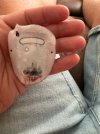Hello everyone I'm new to the forum.
Just thought I would share my experience over the last few weeks of adjusting to the Omnipod 5 and Libre 2+ in the hope that it might be useful for someone.
Positives:
My nighttime levels are brilliantly consistent for the first time in years. I go cycling regularly sometimes carrying camping gear up hills and previously this has led to multiple hypos during the ride and more severely and frequently the night after. This in spite of halving basal rates, reducing boluses etc. Recently I did a two day ride and camp in the Peak District following the instructions to use the Acivity setting (which I applied for 48 hours) and reduce boluses by 25%. To my amazement I did not get a hypo in the night at all, and only one or two during the ride itself.
My general levels are less spiky by a long chalk so long as I am careful with carb-counting.
Fewer hypos generally.
Easier to give a quick bolus for a snack.
Negatives:
Not much support after training to answer the questions I didn't think to ask (but I haven't contacted my clinic).
PDM daily losing contact with the sensor (often at the most inconvenient moment eg just before a meal) for an hour or more. After talking to Insulet and Abbott I have replaced the Libre and that seems better so far. (Abbott sent me a new one).
No way of getting alerts/notifiacations on my phone (useful when driving or cycling).
No way of using a reader to give an instant check. This was part of my swimming routine when I would keep the reader at the end of the lane and check my levels every 16 lengths or so. I wasn't sure if the sensor and the pod would talk to each other in the pool and worried about having a hypo as I no longer get the clear warnings as I used to years ago. Somehow dealing with a hypo when you're in the pool seems particularly awkward. I tried putting the PDM at the end of the lane but it lost contact when I was swimming and so I had to wait for some minutes before getting the reassurance I wanted. I am learning to trust the system a bit more and today I left the PDM in the locker and all was fine. I can't resist a little carb pre-loading though, although Insulet say it isn't necessary. Perhaps next week...
I am not sure if the pod will still respond to the sensor when out of the PDM range.
It looks from this as if the negatives outweigh the positives, but although the loss of contact for extended periods is frutrating, I am overall very pleased with the ease of managing my diabetes. I hope this will be reflected in my overall glucose levels, but the big win for me at the moment is the day-to-day convenience.
Cheers
Adrian
Just thought I would share my experience over the last few weeks of adjusting to the Omnipod 5 and Libre 2+ in the hope that it might be useful for someone.
Positives:
My nighttime levels are brilliantly consistent for the first time in years. I go cycling regularly sometimes carrying camping gear up hills and previously this has led to multiple hypos during the ride and more severely and frequently the night after. This in spite of halving basal rates, reducing boluses etc. Recently I did a two day ride and camp in the Peak District following the instructions to use the Acivity setting (which I applied for 48 hours) and reduce boluses by 25%. To my amazement I did not get a hypo in the night at all, and only one or two during the ride itself.
My general levels are less spiky by a long chalk so long as I am careful with carb-counting.
Fewer hypos generally.
Easier to give a quick bolus for a snack.
Negatives:
Not much support after training to answer the questions I didn't think to ask (but I haven't contacted my clinic).
PDM daily losing contact with the sensor (often at the most inconvenient moment eg just before a meal) for an hour or more. After talking to Insulet and Abbott I have replaced the Libre and that seems better so far. (Abbott sent me a new one).
No way of getting alerts/notifiacations on my phone (useful when driving or cycling).
No way of using a reader to give an instant check. This was part of my swimming routine when I would keep the reader at the end of the lane and check my levels every 16 lengths or so. I wasn't sure if the sensor and the pod would talk to each other in the pool and worried about having a hypo as I no longer get the clear warnings as I used to years ago. Somehow dealing with a hypo when you're in the pool seems particularly awkward. I tried putting the PDM at the end of the lane but it lost contact when I was swimming and so I had to wait for some minutes before getting the reassurance I wanted. I am learning to trust the system a bit more and today I left the PDM in the locker and all was fine. I can't resist a little carb pre-loading though, although Insulet say it isn't necessary. Perhaps next week...
I am not sure if the pod will still respond to the sensor when out of the PDM range.
It looks from this as if the negatives outweigh the positives, but although the loss of contact for extended periods is frutrating, I am overall very pleased with the ease of managing my diabetes. I hope this will be reflected in my overall glucose levels, but the big win for me at the moment is the day-to-day convenience.
Cheers
Adrian

